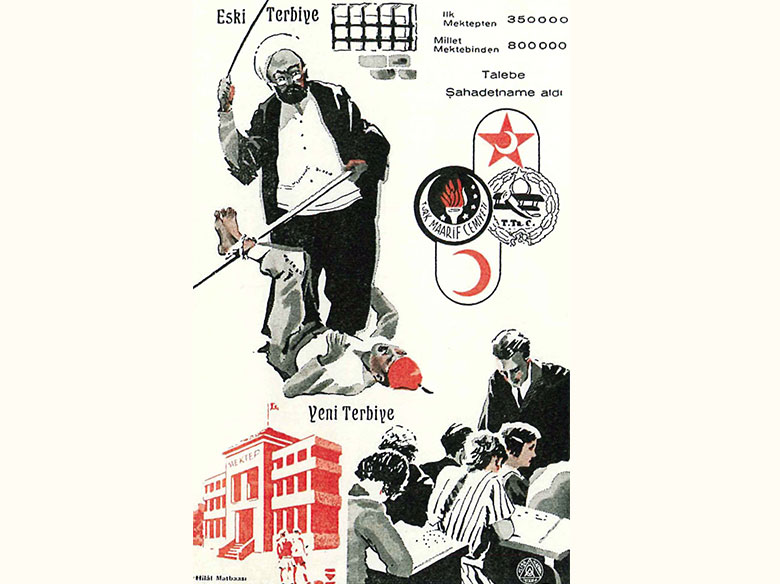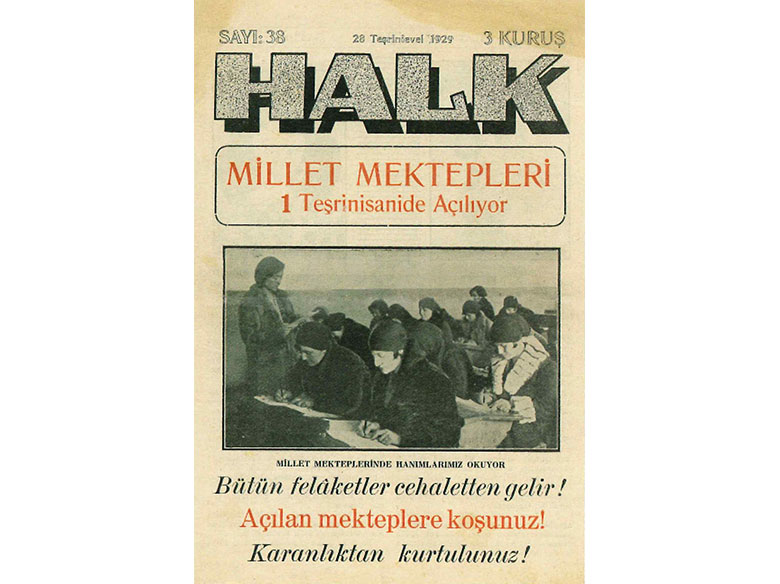
Card published for the 10th year of the Republic, showing old and new manners. Turan Tanyer Archives.
Education During the Atatürk Era
Dated 29 December 1923, the Ministry of Education sent a memorandum to directorates of education. It began with the words, “We are obliged to lend a new direction to the methods of instruction,” and strongly emphasized the “instruction” that the new Republic sought:
“The school education of the past, which left the children and youngsters in a state of passivity and blind obedience, must now give way to an active form of education that considers young individuals as independent and responsible members of this nation. Relying on the sovereignty of the nation, the schools of our young government of the Republic are obliged to indoctrinate loyalty to the principles of the Republic in the education they offer.”
The route envisaged for the young Republic was now evident. Per Law no. 430 on the Unification of Instruction, education in Turkey was centralized. Article 1 of the Law stated, “All the scientific and educational institutions in Turkey are connected to the Ministry of Education”, whereas Article 2 stipulated, “All the madrasas and schools administered by the Ministry of Religious Affairs or private foundations are transferred to and affiliated with the Ministry of Education.” This legal arrangement was the first step towards the process of lending the Republic a secular character. The cultural dichotomy that continued for a hundred years was removed from the institutional context; the madrasas were shut down. Vasıf Bey, who was soon put in charge of the Ministry of Education, began work with the following resoluteness: “I am obliged to follow [the Law]. From this point onwards, there will be a single school, a single education, a single curriculum in Turkey.”
On 23 April 1924, the Scientific Commission reconvened in Ankara to discuss educational and cultural affairs. Course schedules were created, school books and school terms were identified. A “primary school program” was designed for the very first time. Changes were made to the content of middle school courses. Sociology was included in the curriculum.
Towards the Village
In his opening address at the Parliament on 1 March 1922 during the years of National Struggle, Atatürk spoke of eliminating ignorance, educating the villagers, providing equal opportunity to women:
“I once said that villagers are the true owners of this country and the fundamental element of our social structure. The same villager has been deprived of the light of education to this day. Therefore, the basis of the educational policy we shall purse is primarily focused on overcoming ignorance. Without going into much detail, I shall explain this idea in a few words. Teaching, to all villagers without exception or discrimination, how to read and write, providing them with enough knowledge about geography, history, religion, and ethics to help them understand their country, nation, religion and world, and offering them vocational expertise, constittue the fundamental objectives of our educational program.”
Village teacher training schools were opened to train teachers specifically for schools in rural areas. Primary school graduates would be admitted to the schools opened in 1926 and 1927 in the Zencidere Village of Kayseri and Denizli, respectively. After a three-year training, they would be sent to village schools as teachers.
The plan was pertinent, yet the possibilities were limited. Since they were unable to obtain a sufficient number of village teachers, the schools were closed. After a decade, the door to another path was pushed ajar: Village Instructors.
Village Instructors would undertake the education in villages without enough population to be assigned teachers and guide villagers to carry out the agricultural affairs in a scientific manner. Young, literate villagers who had completed their compulsory military service, engaged in agriculture, and in possession of land and animals were admitted to these courses.
This “new school” concept, which began with village instructors and shed light into the system soon moved towards a different and more advanced level.
Having found itself a “leader” such as İsmal Hakkı Tonguç during the terms of Saffet Arıkan and Hasan-Âli Yücel, this “new school” was none other than the Village Institute.
The most fascinating, yet sorrowful pages of Turkey’s history of education culminate in the story of the Village Institutes.
An extract from Turan Tanyer’s article in the exhibition catalogue.
Click for more information about the exhibition Mindful Seed Thinking Soil.
